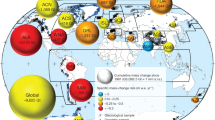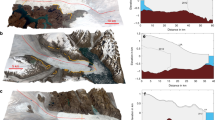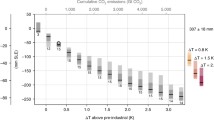Abstract
A large component of present-day sea-level rise is due to the melt of glaciers other than the ice sheets. Recent projections of their contribution to global sea-level rise for the twenty-first century range between 70 and 180 mm, but bear significant uncertainty due to poor glacier inventory and lack of hypsometric data. Here, we aim to update the projections and improve quantification of their uncertainties by using a recently released global inventory containing outlines of almost every glacier in the world. We model volume change for each glacier in response to transient spatially-differentiated temperature and precipitation projections from 14 global climate models with two emission scenarios (RCP4.5 and RCP8.5) prepared for the Fifth Assessment Report of the Intergovernmental Panel on Climate Change. The multi-model mean suggests sea-level rise of 155 ± 41 mm (RCP4.5) and 216 ± 44 mm (RCP8.5) over the period 2006–2100, reducing the current global glacier volume by 29 or 41 %. The largest contributors to projected global volume loss are the glaciers in the Canadian and Russian Arctic, Alaska, and glaciers peripheral to the Antarctic and Greenland ice sheets. Although small contributors to global volume loss, glaciers in Central Europe, low-latitude South America, Caucasus, North Asia, and Western Canada and US are projected to lose more than 80 % of their volume by 2100. However, large uncertainties in the projections remain due to the choice of global climate model and emission scenario. With a series of sensitivity tests we quantify additional uncertainties due to the calibration of our model with sparsely observed glacier mass changes. This gives an upper bound for the uncertainty range of ±84 mm sea-level rise by 2100 for each projection.











Similar content being viewed by others
References
Adhikari S, Marshall SJ (2012) Glacier volume-area relation for high-order mechanics and transient glacier states. Geophys Res Lett 39:L16505. doi:10.1029/2012GL052712
Arendt A et al (2012) Randolph glacier inventory: a dataset of global glacier outlines version: 2.0, 11 June 2012, GLIMS Technical Report
Bahr DB, Meier MF, Peckham SD (1997) The physical basis of glacier volume-area scaling. J Geophys Res 102(B9):20355–20362
Beck C, Grieser J, Rudolf B (2005) A new monthly precipitation climatology for the global land areas for the period 1951 to 2000. German Weather Service, Offenbach
Bevington PR (1969) Data reduction and error analysis for the physical sciences. McGraw-Hill, New York
Bliss A, Hock R, Cogley JG (2013) A new inventory of mountain glaciers and ice caps for the Antarctic periphery. Ann Glaciol 54(63):191–199. doi:10.3189/2013AoG63A377
Burgess D, Sharp M, Mair D, Dowdeswell J, Benham T (2005) Flow dynamics and iceberg calving rates of Devon Ice Cap, Nunavut, Canada. J Glaciol 51:219–230
Chen J, Ohmura A (1990) Estimation of Alpine glacier water resources and their change since the 1870’s. Int Assoc Hydrol Sci Publ 193:127–135
Clarke GKC, Anslow FS, Jarosch AH, Radić V, Menounos B, Bolch T, Berthier E (2012) Ice volume and subglacial topography for western Canadian glaciers from mass balance fields, thinning rates, and a bed stress model. J Climate. doi:10.1175/JCLI-D-12-00513.1
Cogley JG (2009a) A more complete version of the World Glacier Inventory. Ann Glaciol 50(53):32–38
Cogley JG (2009b) Geodetic and direct mass-balance measurements: comparison and joint analysis. Ann Glaciol 50(50):96–100
Cogley JG et al (2011) Glossary of glacier mass balance and related terms. UNESCO-IHP
Columbus J, Sirguey P, Tenzer R (2011) A free, fully assessed 15-m DEM for New Zealand. Survey Q 66:16–19
de Woul M, Hock R (2005) Static mass balance sensitivity of Arctic glaciers and ice caps using a degree-day approach. Ann Glaciol 42:217–224
Dowdeswell JA, Benham TJ, Strozzi T, Hagen O (2008) Iceberg calving flux and mass balance of the Austfonna ice cap on Nordaustlandet, Svalbard. J Geophys Res 113:F03022
Dyurgerov MB (2010) Reanalysis of glacier changes: from the IGY to the IPY, 1960–2008. Data Glaciol Stud 108:1–116
Dyurgerov MB, Meier MF (2005) Glaciers and the changing earth system: a 2004 snapshot. INSTARR occasional paper 58, University of Colorado, Boulder
Gardner AS, Moholdt G, Cogley JG, Wouters B, Arendt AA, Wahr J, Berthier E, Hock R, Pfeffer WT, Kaser G, Ligtenberg SRM, Bolch T, Sharp MJ, Hagen JO, van den Broeke M, Paul F (2013) A consensus estimate of glacier contributions to sea level rise: 2003 to 2009. Science (accepted)
Hock R, de Woul M, Radić V, Dyurgerov M (2009) Mountain glaciers and ice caps around Antarctica make a large sea-level rise contribution. Geophys Res Lett 36:L07501. doi:10.1029/2008GL037020
Huss M (2011) Present and future contribution of glaciers to runoff from macroscale drainage basins in Europe. Water Resour Res 47:W07511. doi:10.1029/2010WR010299
Huss M, Funk M, Ohmura A (2009) Strong Alpine melt in the 1940s due to enhanced solar radiation. Geophys Res Lett 36:L23501
Huss M, Hock R, Bauder A, Funk M (2012) Conventional versus reference-surface mass balance. J Glaciol 58(208):278–286
Jarvis A, Reuter HI, Nelson A, Guevara E (2008) Hole-filled seamless SRTM data V4. http://srtm.csi.cgiar.org. Accessed 29 February 2012
Kållberg PW, Simmons AJ, Uppala SM, Fuentes M (2004) The ERA-40 Archive. ERA-40 Project Report Series 17, ECMWF, Reading
Kaser G, Cogley JG, Dyurgerov MB, Meier MF, Ohmura A (2006) Mass balance of glaciers and ice caps: consensus estimates for 1961–2004. Geophys Res Lett 33. doi:10.1029/2006GL027511
Kaser G, Großhauser M, Marzeion B (2010) Contribution potential of glaciers to water availability in different climate regimes. PNAS 107:20223–20227
Liu HK, Jezek K, Li B, Zhao Z (2001) Radarsat Antarctic mapping project digital elevation model version 2, Digital media. National Snow and Ice Data Center, Boulder. http://nsidc.org/data/nsidc-0082.html
Lüthi MP (2009) Transient response of idealized glaciers to climate change. J Glaciol 55(193):918–930
Marzeion B, Jarosch AH, Hofer M (2012) Past and future sea-level change from the surface mass balance of glaciers. Cryosphere 6:1295–1322. doi:10.5194/tc-6-1295-2012
Meier MF, Dyurgerov MB, Rick UK, O’Neel S, Pfeffer WT, Anderson RS, Anderson SP, Glazovsky AF (2007) Glaciers dominate eustatic sea-level rise in 21st century. Science 317:1064–1067
Moss RH (2010) The next generation of scenarios for climate change research and assessment. Nature 463:747–756. doi:10.1038/nature08823
Paul F, Haeberli W (2008) Spatial variability of glacier elevation changes in the Swiss Alps obtained from two digital elevation models. Geophys Res Lett 35:L21502
Radić V, Hock R (2006) Modelling mass balance and future evolution of glaciers using ERA-40 and climate models—A sensitivity study at Storglaciären, Sweden. J Geophys Res 111:F03003
Radić V, Hock R (2010) Regional and global volumes of glaciers derived from statistical upscaling of glacier inventory data. J Geophys Res 115:F01010. doi:10.1029/2009JF001373
Radić V, Hock R (2011) Regionally differentiated contribution of mountain glaciers and ice caps to future sea-level rise. Nat Geosci 4:91–94. doi:10.1038/NGEO1052
Radić V, Hock R, Oerlemans J (2007) Volume-area scaling vs flowline modelling in glacier volume projections. Ann Glaciol 46:234–240
Radić V, Hock R, Oerlemans J (2008) Analysis of scaling methods in deriving future volume evolutions of valley glaciers. J Glaciol 54(187):601–612
Randall DA et al (2007) Climate models and their evaluation. In: Solomon S et al (eds) IPCC climate change 2007: the physical science basis. Cambridge University Press, Cambridge
Raper SBC, Braithwaite RJ (2006) Low sea level rise projections from mountain glaciers and icecaps under global warming. Nature 439:311–313. doi:10.1038/nature04448
Rastner PN, Mölg T, Machguth H, Paul F (2012) The first complete glacier inventory for the whole of Greenland. Cryosphere 6:1483–1495. doi:10.5194/tc-6-1483-2012
Schiefer E, Menounos B, Wheate R (2007) Recent volume loss of British Columbia glaciers, Canada. Geophys Res Lett 34:L16503
Slangen ABA, Katsman CA, van de Wal RSW, Vermeersen LLA, Riva REM (2012) Towards regional projections of twenty-first century sea-level change based on IPCC SRES scenarios. Clim Dyn 38:1191–1209. doi:10.1007/s00382-011-1057-6
Tachikawa T, Hato M, Kaku M, Iwasaki A (2011) The characteristics of ASTER GDEM version 2, IGARSS
Taylor KE, Stouffer RJ, Meehl GA (2012) An overview of CMIP5 and the experiment design. Bull Am Meteorol Soc 93:485–498. doi:10.1175/BAMS-D-11-00094.1
Woodward J, Sharp M, Arendt A (1997) The influence of superimposed-ice formation on the sensitivity of glacier mass balance to climate change. Ann Glaciol 24:186–190
Zwally HJ, Schutz R, Bentley C, Bufton J, Herring T, Minster J, Spinhirne J, Thomas R (2012) GLAS/ICESat L2 Antarctic and Greenland Ice Sheet Altimetry Data V001. Boulder, CO: National Snow and Ice Data Center. Digital media
Acknowledgments
Funding was provided by NASA grant (NNH10Z1A001N and NNX11AO23G) and NSF (grant EAR-0943742). We thank the two anonymous reviewers for their comments which helped us to significantly improve the manuscript.
Author information
Authors and Affiliations
Corresponding author
Electronic supplementary material
Below is the link to the electronic supplementary material.
Rights and permissions
About this article
Cite this article
Radić, V., Bliss, A., Beedlow, A.C. et al. Regional and global projections of twenty-first century glacier mass changes in response to climate scenarios from global climate models. Clim Dyn 42, 37–58 (2014). https://doi.org/10.1007/s00382-013-1719-7
Received:
Accepted:
Published:
Issue Date:
DOI: https://doi.org/10.1007/s00382-013-1719-7




